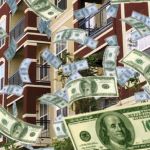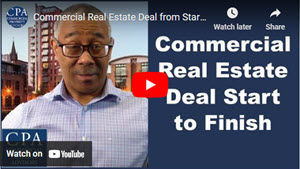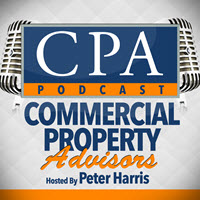
You’re about to learn how investors make the big bucks by doing Value-Add Commercial Real Estate deals. I’m going to share with you how you can make the big bucks yourself by defining value-add commercial real estate, as well as showing you how to evaluate them and how to locate them. Next, I will give you a big bucks roadmap on how to create your own commercial value-add deal. Lastly, I will share with you a real deal from one of our students that purchased a $3 million property and increased the value to $6 million in two and a half years.
To illustrate the Value-Add concept, let’s consider the property value versus years of ownership with two properties…
Property One
The first property’s value is $1 million. I’m going to bring that up to $2 million, however it will take me twenty years to do that. This assumes I’m a good operator and raising my rents consistently. In 20 years, I will increase the cash flow and double the property value. To achieve this growth, I had to wait. Waiting is solution number one to making the big bucks in commercial real estate.
However, waiting isn’t always the right solution for everyone. For instance, if you’re over 40, you don’t have time to wait twenty years. I have a solution for you, and it is with property number two.
Property Two
I’m going to increase the value of my second property from 1 million to 2 million, although it will take me five years instead of twenty. How can I do this? Instead of waiting, I will force the value up by adding value to my commercial property to make it worth more. I am going to force the value and appreciation upward with value-add commercial real estate investing. When I do that, it will increase my property value rapidly. Value-add commercial real estate is solution number two.
Defining Value-Add Commercial Real Estate
Value-add commercial real estate is when you can add value to your commercial property. It can be any type of commercial property. For example, a shopping center, an apartment complex, a retail center, or office building. You add value to the property by doing certain things. What is this value and how do you add it? Let me explain.
To begin with, you need to know the basic terms of commercial deal evaluation. They are not difficult. In fact, you can easily learn them from my video called The Seven Commercial Real Estate Terms You Must Know. Watch it to ensure you understand what I’m teaching here.
Net Operating Income
From reading my blog, you know that as you increase the NOI, or net operating income, this pushes the property value up. What is the NOI? The NOI is your rental income minus your operating expenses. As that number goes up, so does your property value. Next, we need to determine how to increase the NOI.
How to Increase the NOI
- Increase the rents as the leases are renewed.
- Ratio Utility Building System or RUBS. This is when you bill back the tenants for the utilities, taking the burden off you. This increases your cashflow, resulting in an NOI increase as well.
- Add additional income. For instance, we recently discovered that in our neighbourhood everyone was charging $400 for a pet. We began charging new tenants with a pet $400 plus we increased the monthly pet fee to $75. There was no pushback at all from the tenants because they value their pets.
- Reduce expenses by:
- Being more efficient when managing your property and hiring capable management who are efficient.
- Contesting your property taxes. If you think your property taxes are too high, you can hire a firm that will contest your property taxes to get them reduced.
- Cutting expenses in other ways. If you look at your income expense statements, there may be something unnecessary that you can start cutting out.
In short, as you increase your NOI, you increase your property value. That is how you add value to your commercial property, hence the phrase, value-add commercial property.
How to Calculate a Value-Add Commercial Deal
Once you increase the NOI in a property, the property value goes up as well. How do you calculate that increase in property value?
Value-Add= Increase in NOI divided by Market Cap Rate
Market Cap Rate:
What is the market cap rate? The market cap rate is a compilation of comparable commercial properties. If they’re all multifamily properties, you find out what they’ve sold for. Next, you determine what the cap rates are and average it all together. The result is your market cap rate. To find the market cap rate in your area, you can call a local commercial real estate agent and ask them for the market cap rate for C-class apartments in your neighborhood. You can then use that number to calculate the value-add.
Example Properties Increasing the NOI
As an illustration of the power of the NOI to increase the value-add in commercial real estate, I will compare a single-family home with a 16 unit. Then I’m going to compare that with a 90 unit. This will enable you to see the differences between the properties. In the examples, we’re going to assume the market cap rate is 8%.
Single-Family Home:
- I’m going to raise the rent on my single-family home $200/month.
- I will then multiply that increase of $200 by 12 months, which equals $2, 400. That’s $2,400 per year added to my bottom line. That’s the NOI increase per year.
- How much value does this add to my single-family home by increasing the NOI? Unfortunately, none. This formula does not apply to single family homes, only to commercial real estate.
For apartments, it applies to five units and higher, however it does not apply to a fourplex, triplex, duplex or a single-family home. This is why investing in commercial real estate is so powerful. We can force the appreciation up very quickly. In a single-family home, you can double your rent, but the property value stays the same. This is because the property value is determined by your neighbor’s property down the street.
16-unit Apartment Building:
- In this example, I’m raising the rent $200 per month on 16 units.
- I multiply that by 12, which equals an additional $38,400 to my bottom line.
- Using the value-add formula (increase in the NOI divided by the market cap rate), I divide $38,400 by 8% equaling $480,000.
Therefore, I have a value-add of $480,000. My NOI went up $38,400, but the property value went up $480,000. You can see how crucial the NOI is in correlation to the increase in value. This is the beauty of commercial real estate.
90 Unit Property:
- In the final example, the rent is raised $200/month, which I multiply by 90 units.
- I then multiply that by 12 months, giving me a $216,000 increase per year in NOI.
- Finally, I divide $216,000 by an 8% cap rate, which gives me $2.7 million.
That’s the power of the NOI.
How to Find Value-Add Commercial Deals
The next step I’m going to share with you is how to find value-add commercial property. There are no websites to go to or search criteria. Instead, you need to develop a new way of looking for value-add deals.
Establish a New Mindset
You need to develop a new mindset. Looking with that new pair of eyes is simply looking for the value of a property. You need to see how much you can increase the NOI. Just as I demonstrated in the examples above, the increased NOI divided by the market cap rate gives you the value-add of a property. You need to approach every commercial property that you look at this way. Look to see if you can raise the rent, perhaps bill back the utilities, or reduce expenses.
Raise Rents:
How do you know if you can raise the rents or add other income? To see if the rents can be raised on an apartment building, you can go on to rentometer.com. If you want to know whether you can raise the rents for an office building or a warehouse, go onto LoopNet for current rates. There are two options on the site, acquisition and leasing. Choosing leasing will show you what other office buildings and shopping centers are getting for rent per month.
Reduce Expenses:
Another thing to always consider is whether you can reduce expenses. To find out if you can, speak with the property manager. Speaking with them should be your first move because the property manager pays the bills every month, so will know if expenses are high. Getting a mentor will also help you to see if it is possible for you to reduce expenses.
Now, I guarantee you, if you choose 10 properties in your area you’ll be able to do this formula and see the upside in value in two out of those ten.
To summarize, you find value-add commercial real estate by looking at every single property the same way and asking, “Can I increase the NOI?”.
Roadmap to the Big Bucks with Value-Add Commercial Real Estate
1. Get educated:
You must become a student of the game. You can also become our student, but you need to become a student of commercial real estate. Do this by reading books, watching my videos, and meeting people.
2. Focus on one type of property:
There is power in focus. Choose one and become an expert at it. I don’t know anyone who’s extremely good at apartments and shopping centers. I know people who are good at one or the other and make a fortune.
3. Get your team in place:
Assemble your team so you can be taken seriously when it’s time to buy your property. Perhaps get us involved. Hire a property manager, agent and lender.
4. Evaluate lots of commercial properties:
This is so you can see if they have the value-add component. Start examining lots of deals and making lots of offers. You need to go through quite a few to find the property with the numbers that make you excited.
5. Buy a commercial property with value-add:
You’re going to buy a value-add commercial property by following the first four steps.
6. Execute your exit strategy:
In commercial real estate, a well thought out exit strategy is extremely important. The big bucks are made on the exit, so the exit strategy must be conservative and precise. If you are a beginner, do not try to do it yourself. You need someone with experience to help you.
A Protégé Deal
In conclusion, I’m going to share with you a deal that one of my protégés Chris did and provide a link at the bottom of the page to his story. He took a $3 million property and he increased its value to $6 million in about two and a half years. Chris was looking to invest in commercial real estate. He had a retirement plan that was doing okay, but he was nowhere near reaching his retirement goals. For this reason, he came to us and joined our program. His first deal was a 90-unit apartment building. We mentored him, developing a value-add strategy for fixing up the property, raising the rents, and hiring good management. We put all that together in the first 12 months. Watch his story and see how he is an example of the power of value-add commercial real estate.
Here’s the full story on Chris: How Chris Became a Millionaire in 1 Year



